A delicious 4-ingredient Pandan Jelly recipe made in minutes (excluding the setting time.) Cooling and refreshing, it's the perfect summer dessert with a delicate flavor that some say is reminiscent of vanilla. (Not if you ask me!) When made with agar agar powder, the jellies can even be packed as lunch box or camping snacks, as they won't melt at room temperature! (This is NOT the Vietnamese Jelly, Che Banh Lot.)

Jump to:
⭐ Why This Recipe is a Star
- Pandan jelly is a simple but delicious dessert: it's a 3-step, 3-ingredient recipe. So easy that it's 1 of the first foods Singaporean kids learn to make!
- Perfect for summer: agar agar has a beautifully firm and bouncy texture that's light, refreshing and cooling. Serve it with some homemade pandan tea on the side!
- Super versatile: you can make the recipe as is, add coconut milk or layer it with other flavors to make a rainbow jelly! Alternatively, add some coconut pulp or nata de coco to give it more texture!
What is Pandan?
Pandan is a popular flavor in Southeast Asia and used in many traditional Asian desserts. This tropical plant has very fragrant leaves are long and pointy, with an aroma that some say is reminiscent of the warm notes of vanilla. (Not to me personally.)
It's used in anything from Thai desserts as well as Singaporean Malaysian savory dishes, such as Kueh Dadar, Pandan Rice and Pandan Latte, for the flavor and to turn foods green.
Note: there is a Vietnamese version of pandan jelly (Che Banh Lot) which uses mung bean starch as a thickener instead.
🥘 Ingredients

You will need:
- pandan juice: I used homemade pandan juice. (There are 2 types of pandan leaves, also known as screw pine leaves. One is used for color and the other for fragrance. I only used the fragrant type of pandan, which is why my green is not as strong. For a darker color, you will need to use the 2nd type of pandan leaf too.) If you substitute with the artificial pandan version, the color will be much brighter, almost fluorescent. However, the color will be more even. (Those are available at Asian supermarkets.) You can also substitute with pandan syrup, in which case, you will no longer need to add sugar.
- agar agar powder (kanten): make sure you get the no-color, unsweetened version. If using the version with sugar, omit the sugar below. Agar agar is naturally vegan. If you're not plant-based, you can substitute with gelatine or 1 of these agar powder substitutes. Do note that gelatine-based jellies won't keep their shapes at room temperature, unlike agar jelly. If using agar flakes or agar bars instead of powder, you'll need to soak them in water first to soften them. Use 3T of the flakes instead of 2T of agar powder.
- sugar: I use white granulated sugar but caster is fine too. You can even use brown sugar, coconut sugar or palm Gula Melaka, but your jelly will no longer be a gorgeous green and be brown instead! (Make sure your sugar has no bone char if you're making this as a vegan dessert.) You can also omit the sugar if you use coconut water (which has some natural sweetness) or want to serve the jelly with a pandan syrup instead.
- water, optional: you can make this jelly with 100% pandan juice but if you don't have enough, just top up with water. (Quantities in the recipe card below.) You can also use coconut water.
- pinch of salt, optional: salt enhances the flavor!
📖 Variations & Substitutes
- Creamy Pandan Coconut Jelly: Instead of using water, substitute with coconut milk but note that this will create an opaque jelly and not a clear translucent one. Make sure you use unsweetened coconut milk or the jelly will be sickly sweet.
- Coconut Pandan Jelly with Layers: you can make jelly with different flavors and colors, by pouring different jelly mixtures on top of each other. For example, there's a coconut-pandan jelly called Wun Gati Bai Tuey. First, pour the pandan layer (or whichever jelly you want to be the base) and allow it to almost set, then pour the 2nd layer (I recommend a coconut layer or mango jelly) and allow to set. The 1st green layer needs to be firm to the touch, but still warm when you pour the 2nd layer on top. If the 1st layer hasn't set enough, you'll end up with a marbled effect, rather than 2 distinct coloured layers. If it has cooled down, the 2 layers won't adhere to each other.
🔪 Step-by-Step Instructions

1a. Mix the agar powder with the sugar (this helps prevent clumping later).
1b. Add the pandan extract and water to the pot.
1c. Whisk the agar-sugar mixture into the pot of liquid. Do not mix into hot liquid or there will be lumps!

2. Switch on the fire and bring the pot to the boil over medium heat, whisking continuously.
Note: Make sure it boils as agar won't dissolve in cold water.

3a. Once boiling, switch off the heat, pour into the heat-proof moulds and allow to cool. If you want a smooth layer, poke out the bubbles with a toothpick (or skim them off.)
Note: It will take about 3 hours in the fridge, preferably longer. I find silicone molds work best.
3b. When set, you can use cookie cutters to cut out shapes or simply cut into squares or small rectangles using a knife. (Don't use a table knife if you don't want the jagged edges!)
Note: You may need to run a knife around the edges of the container to loosen the jelly, or it won't come out easily.
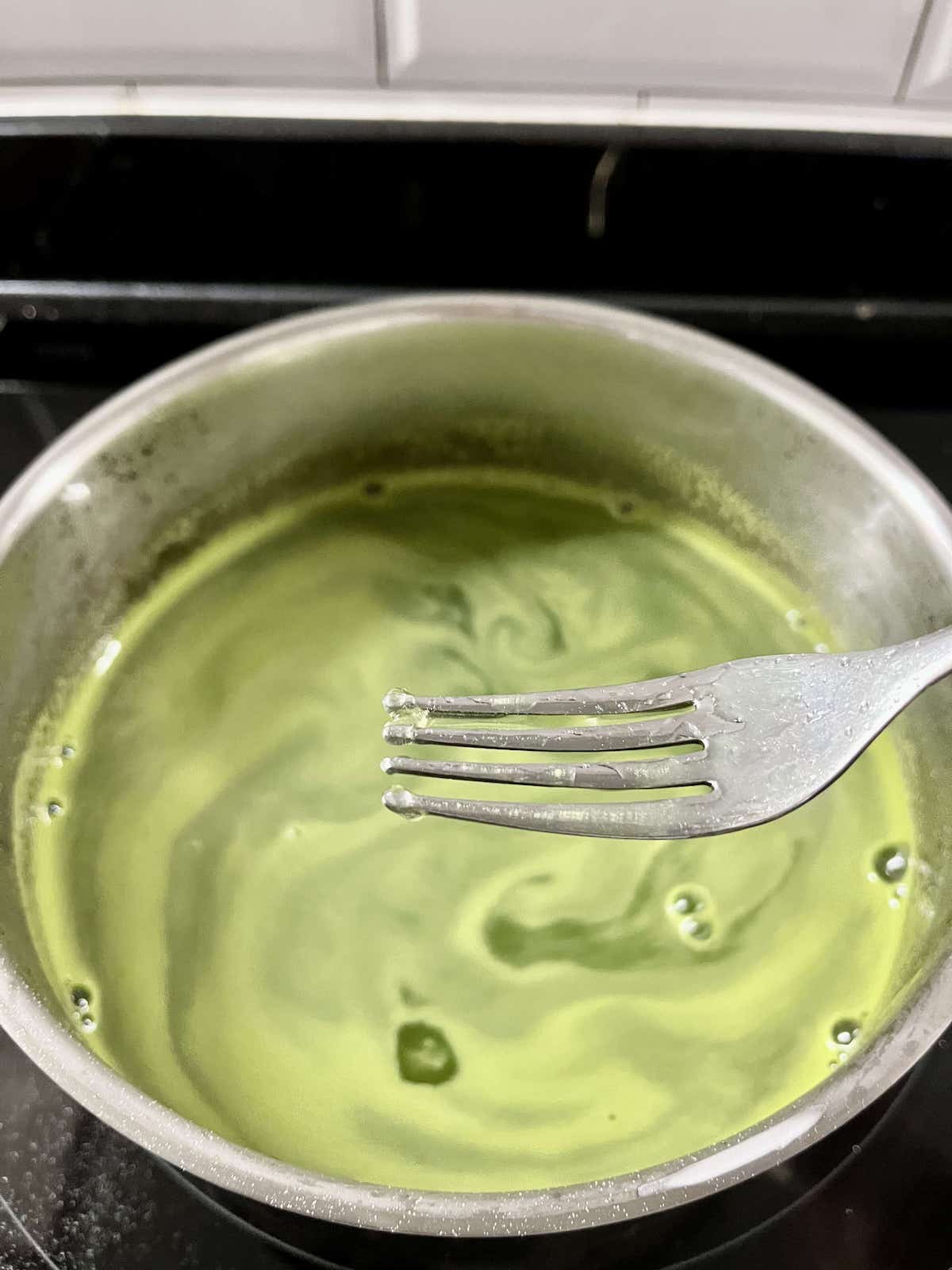
As mentioned, agar agar jelly clumps easily when added to a hot liquid. If you look at the tines of the fork, you can see little lumps of agar at the ends.
🥡 How to Store
Store in the fridge in an airtight container for up to 3 days.
👩🏻🍳 Expert Tips
Tip #1: Silicone baking molds, like the flower ones I uses for my yuzu konjac jellies, are perfect for setting agar agar as they make it easier to pop the jellies out again.
Tip #2: If making your own pandan juice, don't use more leaves than the recipe calls for, or the grassy notes of pandan will be too strong.
💭 Recipe FAQs
In Southeast Asia, coconut, lemongrass, palm sugar and mango are all flavors that are often used with pandan in sweet food. For savory food, pandan is often paired with coconut milk (or coconut cream), galangal, lemongrass, garlic and ginger.
There are 3 reasons: firstly, the liquid may not have gotten hot enough (bring it to a boil as agar doesn't dissolve in cold water), secondly, you may not have added enough agar powder and lastly citrus flavors such as lime and pineapple can interfere with the setting of agar.
🥗 Other Pandan Recipes
Enjoyed this easy Pandan Jelly Dessert Recipe? Please leave a 5-star 🌟🌟🌟🌟🌟rating in the recipe card below! If you REALLY liked this dish, please consider supporting it by buying me a coffee! 🙂 (No obligation though!) Thank you and have a great day!
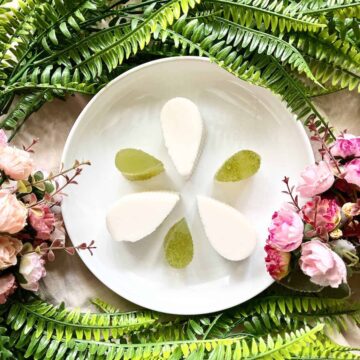
Pandan Jelly (Agar Agar)
Equipment
- Blender and sieve if making your own pandan juice
- Pot and something to stir the mixture
- Silicone mold/ heat-proof container To set the jellies
Ingredients
- 1 Cup pandan juice Homemade pandan extract or shop bought work. If using homemade, remember to stir the jelly after pouring it into the mold, to ensure the green color is well-spread out and not clumping.
- 3 Cups water You can use coconut water too as coconut goes very well with pandan. The 2 flavors are often used together in South East Asian cooking.
- 1½ Tablespoon agar agar powder Using more powder will make the jelly harder, whilst using too little will thicken but not set it.
- ⅔ Cup white sugar Other sugars, such as brown sugar, work too but they will change the color of the jelly. If you don't mind that, lemongrass syrup actually complements pandan beautifully too!
Instructions
- To prevent clumping: Mix the agar powder with the sugar and salt, if using.
- Add the pandan juice and water to the pot. (If making pandan coconut jelly, substitute the water with coconut water, coconut milk or coconut cream.)
- Whisk the agar-sugar mixture into the pot of liquid. Important: Do not mix into hot liquid or there will be lumps!
- Switch on the fire and bring the pot to the boil whisking continuously.
- Once boiling, switch off the heat, pour into the heat-proof moulds and allow to cool. It will take about 3 hours in the fridge, preferably longer.
- To remove from the molds: pop out if using silicone baking ones. If not, cut into desired shapes. run a knife around the edges of the container to loose then jelly, turn gently turn the container over. You may need to give it a gentle tap to get it out. Remember to use a sharp knife so there won't be jagged edges. (I used a table knife and you can see the edge isn't quite straight.)
Notes
- Did the liquid get hot enough? (bring it to a boil as agar doesn't dissolve in cold water)
- Did you add enough agar powder/ agar flakes etc? (If not you get a thick jam not a jelly.)
- Are you using citrus flavors such as lime and pineapple? These can interfere with the setting of agar.
Note: the nutritional information is an estimate automatically calculated using the WPRM recipe maker and I am not responsible for its veracity.
Nutrition
If this Singapore vegan jelly recipe was helpful, maybe you'd like to sign up for my newsletter in which I send you more tips and tricks to make authentic Asian food?

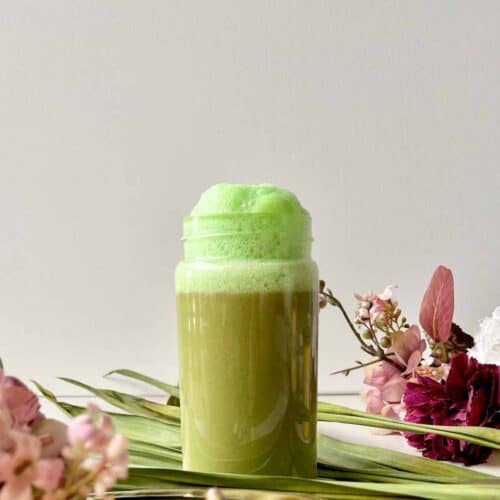
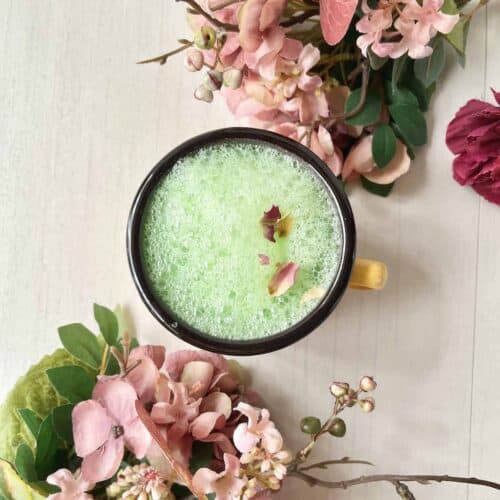
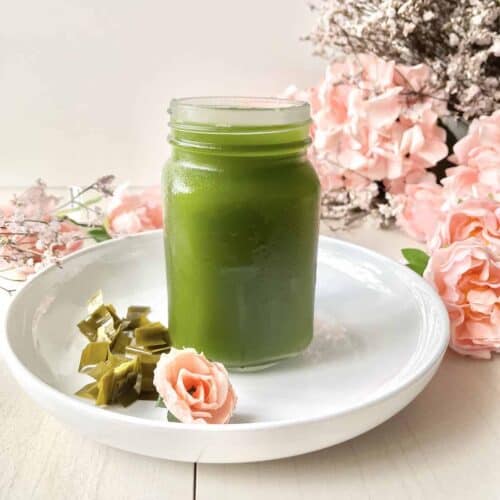
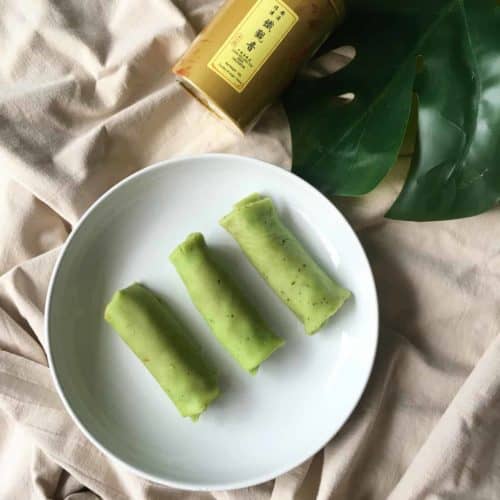
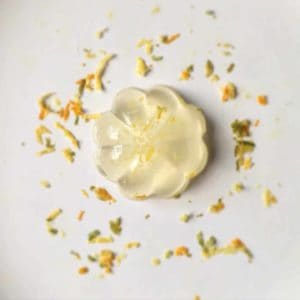
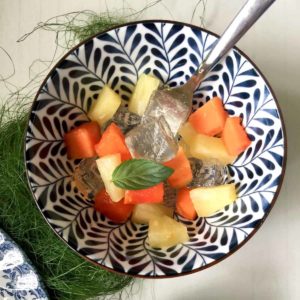
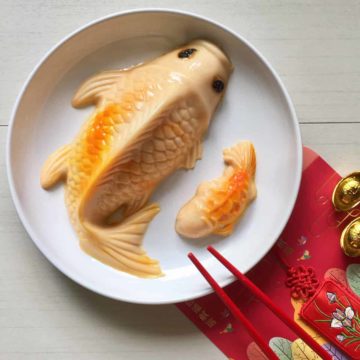
Helen at the Lazy Gastronome says
This recipe intrigued me. I've never used agar agar but I've been curious. And I've never heard of pandan juice - SO - I ordered some pandan extract to make juice and some agar agar and tried it. These little jellies are delicious - really refreshing!! And the recipe gives you a lot of info for working with these ingredients. Pinned!
Zen says
Thanks so much Helen, so glad you liked the recipe and so touched you went to the extra trouble of ordering pandan just to try it!! Love the name of your blog and the shrimp in spicy lemon butter sauce was just divine!! (Shared on my socials :))
Andréa Janssen says
I love pandan, but never had it as a jelly. But this was really delicious and easy to prepare. Thank you for the recipe!